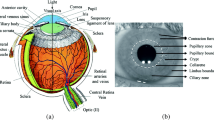Abstract
With the recent developments in information technology, health diagnosis based on iris analysis and biometrics has received considerable attention. For iris recognition, iris localisation, which is not an easy task, is an important phase. Moreover, for iris localisation, dealing with nonideal iris images could cause an incorrect location. Conventional methods for iris location involve multiple searches, which can be noisy and outdated. Such techniques could be inaccurate while describing pupillary boundaries and could lead to multiple errors while performing feature recognition and extraction. Hence, to address such issues, we propose a method for iris localisation of both ideal and nonideal iris images. In this research, the algorithm operates by determining all regions of interest (ROI) classifications through the use of a support vector machine (SVM) as well as the application of histograms that use grey levels as descriptors in all regions from those exhibiting growth. The valid region of interest (ROI) obtained from the probabilities graph of an SVM was obtained by examining the global minimum conditions determined using a second derivative model of the graph of functions. Moreover, this helped to eliminate the sensitive noises and decrease the calculations while reserving relevant information as far as possible. During the experiment, the comparison edge detection method was used with Canny and a multi-resolution local approach. The results demonstrated that the proposed ROI provided better results compared with those obtained without ROI.
Access this chapter
Tax calculation will be finalised at checkout
Purchases are for personal use only
Similar content being viewed by others
References
Wang M, Jin JS, Jing Y, Han X, Gao L, Xiao L (2016) The improved canny edge detection algorithm based on an anisotropic and genetic algorithm, vol 634, pp 115–124
Canny J (1986) A computational approach to edge detection. IEEE Trans Pattern Anal Mach Intell 8(6):679–698
Jie G, Ning L (2012) An improved adaptive threshold canny edge detection algorithm. In: 2012 International conference on computer science electronics engineering, pp 164–168
Otsu N (1979) A threshold selection method from gray-level histograms. IEEE Trans Syst Man Cybern 9(1):62–66
Al-Kubati AAM, Saif JAM, Taher MAA (2012) Evaluation of Canny and Otsu image segmentation. In: International conference on emerging trends in computer and electronics engineering, pp 23–25
Anitha R, Jyothi S (2014) Classifying penaeid prawns species using Canny and Otsu. Int J Adv Res Comput Sci. Manag Stud 2(11):35–42
Fang M, Yue G, Yu Q (2009) The study on an application of otsu method in canny operator. In: International symposium on information …, vol 2, no 4, pp 109–112
Zhao J, Yu H, Gu X, Wang S (2010) The edge detection of river model based on self-adaptive canny algorithm and connected domain segmentation. In: 2010 8th World congress on intelligent control and automation, vol 2, no 1, pp 1333–1336
Othman Z, Abdullah A (2017)An Adaptive threshold based on multiple resolution levels for canny edge detection. In: IRICT 2017 Recent trends information and communication technology, pp 316–323
Othman Z, Abdullah A, Prabuwono AS (2012) A statistical approach of multiple resolution levels for canny edge detection. In: Intelligent systems design and applications (ISDA), pp 837–841
Hui P, Ruifang Z, Shanmei L, Youxian W, Lanlan W (2011) Edge detection of growing citrus based on self-adaptive canny operator. In: 2011 International conference on computer distributed control and intelligent environmental monitoring, pp 342–345
Abdullah A, Veltkamp RC, Wiering MA (2009) Spatial pyramids and two-layer stacking SVM classifiers for image categorization: a comparative study. In: Proceeding of international joint conference on neural networks, pp 5–12
Zhao Y, Ti C, Huang X, Tokuta A, Yang R (2014) A performance comparison between circular and spline-based methods for iris segmentation. In: Proceeding—International conference on pattern recognition, pp 351–356
Celik ET (2016) Selecting a fuzzy region of interest in standard eye images. Adv Intell Syst Comput 357:793–804
Li Y, Li W, Ma Y (2012) Accurate iris location based on region of interest. In: Proceeding—2012 International conference biomedical engineering biotechnology, iCBEB 2012, pp 704–707
Othman Z, Abdullah A, Prabuwono AS (2018) Supervised growing approach for region of interest detection in Iris localisation. Adv Sci Lett 24(2), 1005–1011(7)
Zucker SW (1976) Region growing: childhood and adolescence. Comput Graph Image Process 5(3):382–399
Cortes C, Vapnik V (1995) Support-vector networks. Mach Learn 20(3):273–297
Business J (2010) An improved algorithm for iris location. In: 2010 International conference on computer, mechatronics, control and electronic engineering (CMCE), pp 219–221
Abdou IE, Pratt WK (1979) Quantitative design and evaluation of enhancement/thresholding edge detectors. Proc IEEE 67(5):753–763
CASIA-IrisV2. [Online]. Available http://biometrics.idealtest.org/
Santos R, Alexandre A (2010) The UBIRIS . v2 : a database of visible wavelength Iris images captured. Analysis 32(8), 1529–1535
Acknowledgements
The authors express their deepest gratitude and thanks to Universiti Teknikal Malaysia Melaka (UTeM) in supporting this research PJP/2018/FTMK(2B)/S01629.
Author information
Authors and Affiliations
Corresponding author
Editor information
Editors and Affiliations
Rights and permissions
Copyright information
© 2019 Springer Nature Singapore Pte Ltd.
About this paper
Cite this paper
Othman, Z., Abdullah, A., Kasmin, F., Ahmad, S.S.S. (2019). Effect of Supervised Region of Interest Against Edge Detection Method for Iris Localisation. In: Piuri, V., Balas, V., Borah, S., Syed Ahmad, S. (eds) Intelligent and Interactive Computing. Lecture Notes in Networks and Systems, vol 67. Springer, Singapore. https://doi.org/10.1007/978-981-13-6031-2_44
Download citation
DOI: https://doi.org/10.1007/978-981-13-6031-2_44
Published:
Publisher Name: Springer, Singapore
Print ISBN: 978-981-13-6030-5
Online ISBN: 978-981-13-6031-2
eBook Packages: Intelligent Technologies and RoboticsIntelligent Technologies and Robotics (R0)




